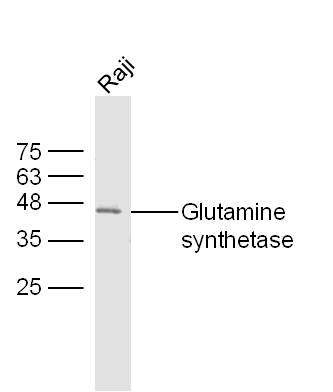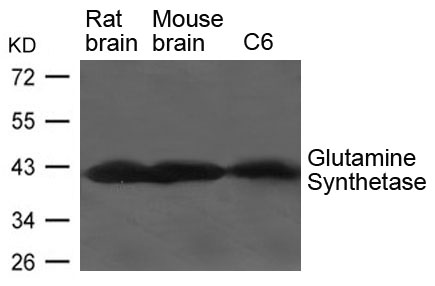Glutamine synthetase antibody [GT1055]
GTX630654
ApplicationsImmunoFluorescence, Western Blot, ImmunoCytoChemistry, ImmunoHistoChemistry, ImmunoHistoChemistry Frozen, ImmunoHistoChemistry Paraffin
Product group Antibodies
TargetGLUL
Overview
- SupplierGeneTex
- Product NameGlutamine synthetase antibody [GT1055]
- Delivery Days Customer9
- Application Supplier NoteWB: 1:500-1:3000. ICC/IF: 1:100-1:1000. IHC-P: 1:100-1:1000. IHC-Fr: 1:100-1:1000. *Optimal dilutions/concentrations should be determined by the researcher.Not tested in other applications.
- ApplicationsImmunoFluorescence, Western Blot, ImmunoCytoChemistry, ImmunoHistoChemistry, ImmunoHistoChemistry Frozen, ImmunoHistoChemistry Paraffin
- CertificationResearch Use Only
- ClonalityMonoclonal
- Clone IDGT1055
- Concentration1 mg/ml
- ConjugateUnconjugated
- Gene ID2752
- Target nameGLUL
- Target descriptionglutamate-ammonia ligase
- Target synonymsDEE116, GLNS, GS, PIG43, PIG59, glutamine synthetase, cell proliferation-inducing protein 59, glutamate decarboxylase, glutamine synthase, palmitoyltransferase GLUL, proliferation-inducing protein 43
- HostMouse
- IsotypeIgG1
- Protein IDP15104
- Protein NameGlutamine synthetase
- Scientific DescriptionGlutamine is a main source of energy and is involved in cell proliferation, inhibition of apoptosis, and cell signaling (Haberle et al., 2005 [PubMed 16267323]). Fetal glutamine requirements are very high and depend largely on active glutamine synthesis and the release of glutamine into the fetal circulation by the placenta. Glutamine synthetase (EC 6.3.1.2), also called glutamate-ammonia ligase (GLUL), is expressed throughout the body and plays an important role in controlling body pH and in removing ammonia from the circulation. The enzyme clears L-glutamate, the major neurotransmitter in the central nervous system, from neuronal synapses (see references in Clancy et al., 1996 [PubMed 8975719]).[supplied by OMIM]
- Storage Instruction-20°C or -80°C,2°C to 8°C
- UNSPSC12352203
References
- Jhu JW, Yan JB, Lin ZH, et al. SREBP1-Induced Glutamine Synthetase Triggers a Feedforward Loop to Upregulate SREBP1 through Sp1 O-GlcNAcylation and Augments Lipid Droplet Formation in Cancer Cells. Int J Mol Sci. 2021,22(18). doi: 10.3390/ijms22189814Read this paper
- Lin D, Reddy V, Osman H, et al. Additional Inhibition of Wnt/β-Catenin Signaling by Metformin in DAA Treatments as a Novel Therapeutic Strategy for HCV-Infected Patients. Cells. 2021,10(4). doi: 10.3390/cells10040790Read this paper
- Seki T, Sato M, Konno A, et al. d-Cysteine promotes dendritic development in primary cultured cerebellar Purkinje cells via hydrogen sulfide production. Mol Cell Neurosci. 2018,93:36-47. doi: 10.1016/j.mcn.2018.10.002Read this paper






![ICC/IF analysis of COS7 cells transiently transfected with Glutamine synthetase plasmid using GTX84426 Glutamine synthetase antibody [1F4].](https://www.genetex.com/upload/website/prouct_img/normal/GTX84426/GTX84426_1079_ICCIF_w_23061420_952.webp)